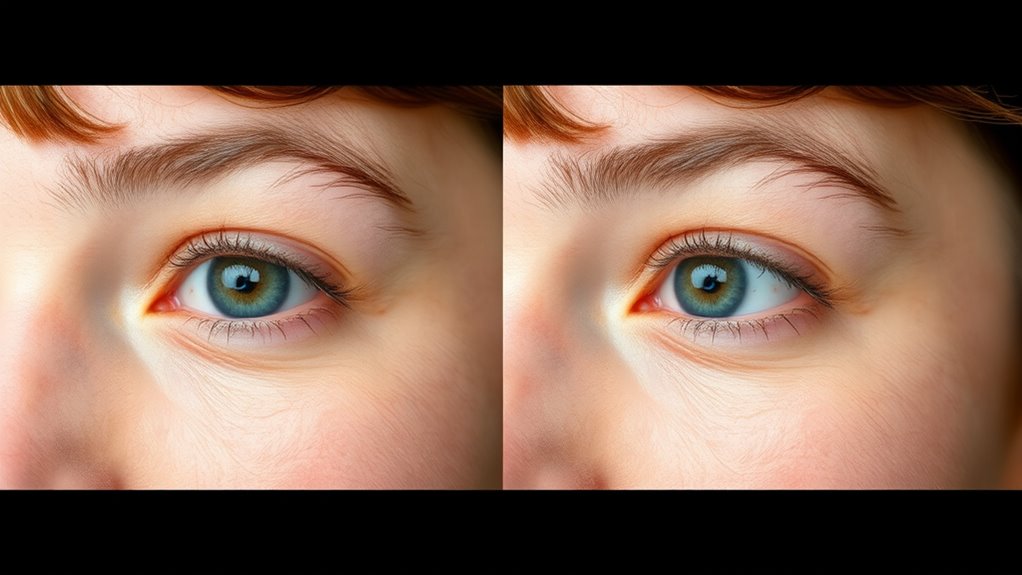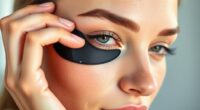With weekly eye patch use, you’ll notice gradual improvements over time. In the first week, subtle changes in eye sensation and function may appear, with little visual improvement yet. By weeks 2-3, the weaker eye strengthens, and focus feels easier. Around weeks 4-5, clarity and eye alignment improve noticeably. Long-term, your vision becomes sharper, and eye health benefits persist. If you keep at it, you’ll see steady progress—continue on to learn more about your eye’s transformation.
Key Takeaways
- Initial week shows subtle eye sensations with minimal visual change, as the body begins to rebalance visual input.
- By 2nd–3rd week, the weaker eye strengthens, improving focus, depth perception, and reducing double vision.
- Around 4th–5th week, visual clarity and eye alignment noticeably improve, with a more balanced facial appearance.
- Long-term benefits include sustained visual enhancement, better eye health, and less eye strain with consistent patching.
- Patience and adherence to treatment are essential for gradual yet significant before-and-after improvements.

Wearing an eye patch can lead to noticeable changes in eye health and appearance, making it a popular treatment for various conditions. When you begin ocular therapy with an eye patch, you might initially notice some subtle differences in how your eye feels and functions. Consistent use can promote visual improvement by encouraging the weaker eye to strengthen and coordinate better with the stronger eye. Over time, this can considerably enhance your overall vision, especially if you’re managing issues like amblyopia or recent eye injuries.
Wearing an eye patch can improve vision and eye health over time.
In the first week of patching, many people experience minor adjustments. You might notice some initial discomfort or a slight change in depth perception as your brain adapts to the new visual input. During this period, your eye may also look slightly different — perhaps more relaxed or less strained — as the dominant eye takes a break. While visual improvement isn’t immediately obvious, your body begins to respond to this ocular therapy by gradually rebalancing visual input.
By the second or third week, you may start to see clearer signs of progress. Your weaker eye begins to strengthen, and you might notice improved focus and less eye fatigue during daily activities. For some, this is when they observe a reduction in double vision or better depth perception. The visual improvement becomes more tangible, and tasks that once caused strain — like reading or working on a computer — tend to feel easier and more natural. These changes reinforce the effectiveness of the eye patch as a part of the treatment plan.
As you continue with weekly patching into the fourth or fifth week, the results often become more pronounced. You might find that your visual clarity improves noticeably, and your eye alignment feels more natural. Ocular therapy is working as intended, and your brain is adapting to the new visual signals more efficiently. By this stage, many individuals experience a boost in confidence, seeing a real difference in their eye health and appearance. The once noticeable disparity between eyes diminishes, giving your face a more balanced look.
In the longer term, consistent patching over several weeks or months can lead to sustained visual improvement and better eye health. The key is maintaining regular use, as abrupt discontinuation can hinder progress. You’ll likely notice that your eye feels less strained and more coordinated, and your overall vision becomes sharper. This timeline highlights how patience and commitment to ocular therapy through eye patching can lead to meaningful, positive changes in both your eye health and appearance. Adherence to treatment is crucial for achieving optimal results.
Frequently Asked Questions
How Long Does Each Eye Patch Session Typically Last?
The eye patch duration varies depending on your treatment plan, but generally, each session length ranges from 30 minutes to a few hours. You should follow your doctor’s instructions for session length to guarantee effective results. It’s important to be consistent with your eye patch use, and if you experience discomfort, consult your healthcare provider. Proper session length helps optimize healing and improves your overall eye health.
Are There Any Side Effects From Prolonged Eye Patch Use?
Think of prolonged eye patch use as sailing into choppy waters—you might encounter rough patches like eye strain and skin irritation. While occasional patches usually don’t cause major issues, extended use can lead to discomfort, redness, or irritation around your eye. If you notice persistent eye strain or skin irritation, it’s best to take breaks and consult your healthcare provider. Listening to your body keeps your journey smooth.
Can Eye Patches Improve Vision in Adults?
You might wonder if eye patches can improve your vision as an adult. While they’re primarily used in vision therapy to treat conditions like amblyopia, their effectiveness for adult eye health varies. Patching can strengthen weak eye muscles and improve coordination, but it doesn’t typically restore sharp vision if damage or age-related issues exist. Consult an eye care professional to determine if patching suits your specific needs and goals.
Is There a Recommended Age to Start Using Eye Patches?
There’s no specific age to start using eye patches, but early intervention benefits pediatric eye health, especially for conditions like amblyopia. You should consider patching compliance, ensuring the child wears the patch consistently. Healthcare providers recommend starting patching as soon as an eye condition is diagnosed, often in early childhood, to promote better vision development. The key is maintaining routine use and monitoring progress for the best results.
What Factors Influence the Speed of Improvement?
Imagine your eye patch as a tiny superhero cape, rushing to fix your vision. The speed of improvement depends on your treatment compliance — wear it consistently, or face delays. Age-related factors also play a role; younger eyes often adapt faster, while older eyes might need more patience. So, stay disciplined and consider your age to give your eyes the best shot at quick recovery.
Conclusion
As you compare your eye’s journey from patching days to clearer sight, the transformation is striking. The before reveals a struggle with blurred vision, while the after showcases renewed focus and confidence. Like dawn breaking after a long night, consistent patching brings hope and clarity. Your persistence turns uncertainty into achievement, illustrating how small daily efforts can lead to remarkable change. In this visual shift, you see not just improved vision, but a renewed sense of possibility.








